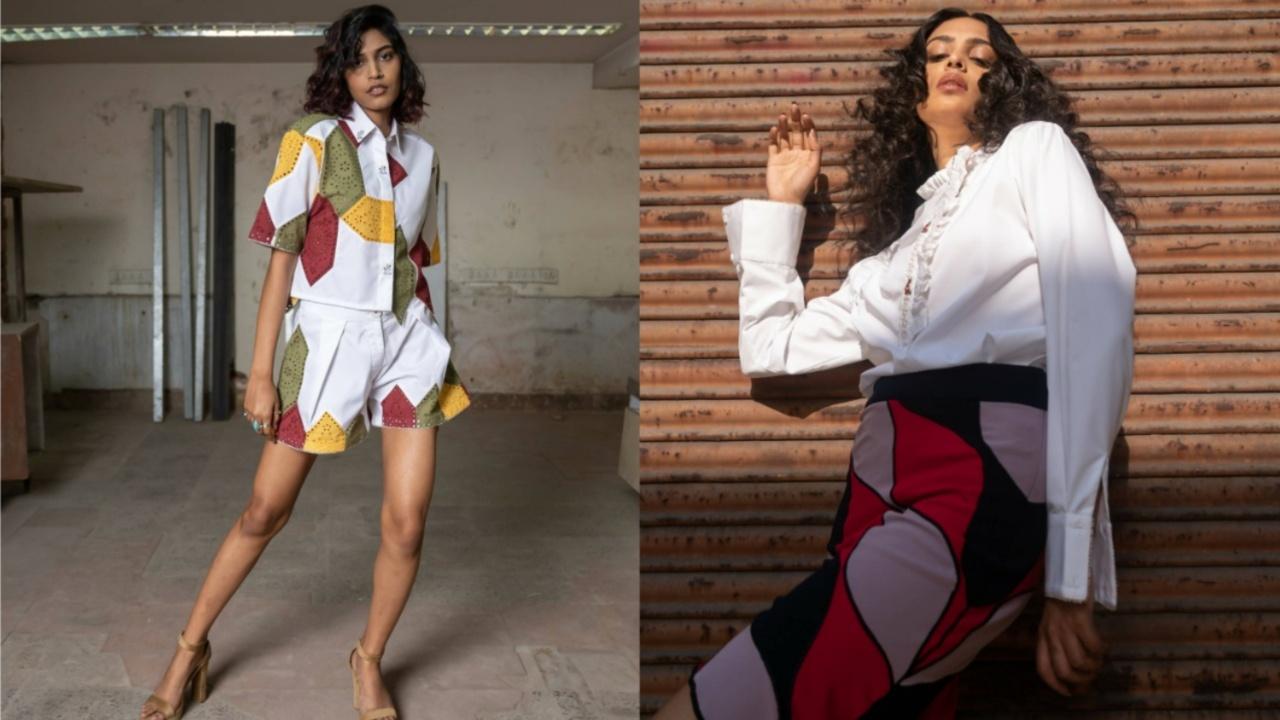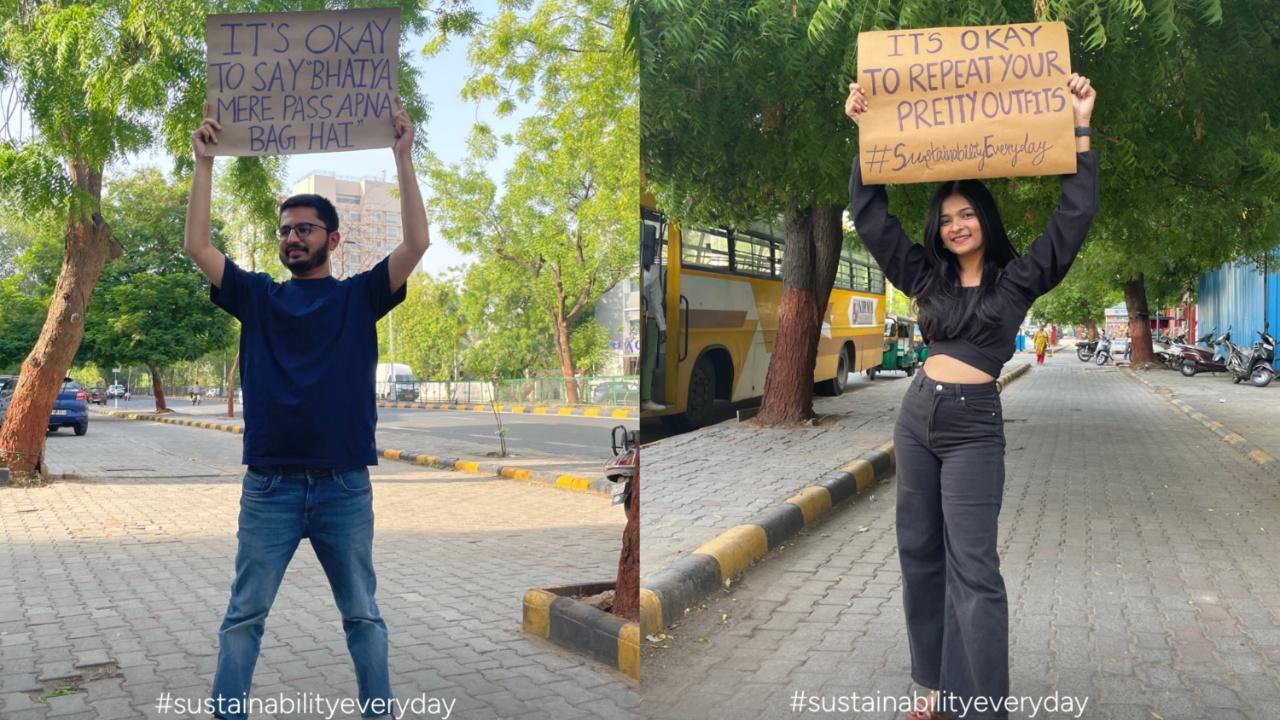Sustainability is a subject that is gaining relevance as human activity speeds up its approach to the planet's limits; some contend that the fashion industry is the second-most polluting in the world, just after oil and gas. Ahead of World Environment Day 2023, we have experts decode how to live an environment-friendly life

The former generations have practised ‘upcycling’ all their lives and set an example about how to use our valuable resources efficiently. Photo Courtesy: Notre Âme, Refash/Akanksha Kaila
Sustainable living and upcycled fashion have become quite popular among all environment-friendly consumers as it protects the earth and also let us stay uncompromisingly fashionable. These consumers mostly consist of Gen Z and those who are willing to make more conscious consumption choices. While a lot of us still love to shop frequently and discard materials after using them hardly any number of times, some ethical lifestyle brands force us to rethink our choices and redirect us to a more beautiful and fulfilling life. On the occasion of World Environment Day 2023, we spoke to two brands to help us embrace a sustainable life and decode simple ways to get started.
“Living sustainably is not about the large steps. It’s about taking small steps every single day and being more conscious of our behaviour,” says Udit Sood, cofounder of Ecoright, a lifestyle brand creating eco-friendly alternatives such as tote bags, sling bags, backpacks, and lunch bags made from organic cotton and recycled plastic bottles.
Sustainable living is a way of life that encourages to reduce carbon footprint by keeping the usage of earth's resources to the minimal for the benefit of the future generations. It involves taking simple steps like reusing items, recycling and reducing waste. For example, choosing to walk or using public transport instead of driving a private car, or using reusable shopping bags instead of single-use plastic bags.
Sood says, “Practicing sustainable living is of utmost importance. The earth has limited resources, and we need to find a way to use them optimally to make them last longer as well as use alternative resources like solar, wind and tidal power. Choosing to live such a life also helps in reducing pollution as minimal resources are used and less waste is produced.”
Here is how you can start living a sustainable life:
1. Reduce, reuse, recycle
Try to minimize the amount of waste you produce, reuse items when possible and recycle when you can
2. Conserve water
Turn off the tap while brushing your teeth, take shorter showers, and use a rain barrel to collect water for gardening
3. Save Energy
Turn off lights when you leave a room, unplug electronics when not in use, and consider energy-efficient appliances. Consider installing solar panels if possible
4. Reduce use of fossil fuels
Walk or use public transportation when you can to reduce your carbon footprint. If you need a car, consider a hybrid or electric vehicle
5. Avoid single-use plastics
Bring your own reusable shopping bags, water bottles, and coffee cups when you go out
6. Buy organic products
Buy locally produced food and organic products to reduce carbon emissions. Choose organic products if you feel it will reduce the use of chemicals in the production process, transportation, and storage. Support companies that practice sustainability. Buy recycled and organic products that can be reused and recycled.
7. Practice mindful buying
Invest in high-quality pieces that are versatile and durable, so they'll last and remain stylish longer. This way, you avoid contributing to the cycle of fast fashion. Ensure you buy less to avoid the wastage of resources. You can also opt for second-hand clothing. Recycle or donate items you no longer need
8. Swap clothes
Arrange clothes swaps with friends or attend swap events. It's a fun, social way to refresh your wardrobe without buying new clothes
“Remember, the goal is not to be perfect but to make better choices when possible. Every small step towards sustainability makes a difference!” says Sood.
How the young are embracing a sustainable life

EcoRight is running a campaign to debunk sustainability myths one placard at a time. Photo Courtesy: EcoRight/Udit Sood
Rucha Gujar, a 25-year-old Borivali West resident is a visual communication and design experience analyst who practices sustainability not just in her personal life but professional life as well by incorporating sustainable UX for a better future. She says, “Since I use electronic devices for a longer duration that heavily uses electric energy, I use battery-saving applications that make use of less energy.” She gives another example of using images in WEBP format instead of JPEG when designing a website as they require less energy to load. Speaking about practising sustainability in her personal life, the designer says, “Many phone apps like Instagram allow you to switch to the dark mode which uses less energy as compared to the white screen. I prefer the dark mode. When it comes to fashion, I buy and use clothes for years. I choose to invest in quality products that are durable. Besides that, I also swap clothes with my sister from time to time cutting down the need to purchase new clothes frequently. When I stop wearing any of my clothes, I either donate them or offer someone else from the family to reuse it. Recently, many fashion brands have put in place recycling practices that encourage customers to return purchased items for recycling purposes. In return, customers are rewarded with extra shopping points on their next purchase. I am soon going to head to the store to return a bag I have been using for years and submit it for recycling.”
How fashion contributes to environmental damage
While we have no control over how governments across the world choose to protect the environment and reduce the harmful effects of climate change by the means of effective implementation of policies, the choice to live a sustainable life that helps the environment is completely under our control. Another area where we can make sustainable and mindful choices is fashion. The fashion industry has become one of the largest polluters of the environment, not just in the way how garments are produced but also in how they are consumed and discarded.
“The fast fashion industry has made fashion less about clothes and more about “fast” trends. With every new trend, the older trend is designed to look obsolete and no longer in “vogue”. According to statistics, women wear a garment approximately 7 times before throwing it away. Some are donated, some are given to charity stores but most of them end up in the landfill. Our landfills are choking with products that were consumed for a short period of time and discarded mindlessly. 95 per cent of the garments that end up on the landfill could have been recycled, re-used or upcycled,” says Akanksha Kaila, founder of Refash, the world’s largest platform for upcycled fashion and interior products.
Upcycled fashion
Upcycling in fashion refers to the creative re-use of a discarded product or material like a garment into a new product of higher value than the original. In simple terms, when you use creativity to bring a waste product back to life by creating something new out of it, it is called upcycling.
It is a form of recycling and although the term may seem new, what it stands for has been a part of our heritage for generations. The former generations have practised ‘upcycling’ all their lives and set an example about how to use our valuable resources efficiently. In older times, people would use the jars or containers discarded by the shopkeepers, to store food items at home. Similarly, old sarees were stitched into bags, purses or frocks for kids.
Kaila says, “We live in a world today where consumption is at its peak. We are in the midst of a use-and-throw economy and discarding products after using them a few times has become the norm. In times like these upcycling is the best solution.”
Upcycled fashion offers many advantages. It helps divert waste products and materials from the landfill, challenges over-consumption and drives consumers towards conscious consumption. It also encourages self-care, repair and mending of old or damaged products using basic skills like stitching, craft or carpentry. Upcycling allows the creation of unique products with a soul.
Although upcycling may sound like a professional skill, there are easy ways that can help you get started on your journey from the comfort of your home.
Kaila lists down some easy tips:
1. Use your creativity to mend garments that have stained or are torn by using natural food dyes like beetroot to dye garments or using thread work to create a pattern where a garment is torn.
2. Buy from upcycling brands which are creating fashion and accessories out of waste.
3. Upcycling is as easy as finding an old dupatta from your mom’s wardrobe and making it into a kaftan! It’s all about seeing possibilities where others would see waste.
4. Fashion is about the expression of personal style, seeing what’s on trend and flaunting the “new”. When you create an upcycled piece for yourself or shop for upcycled products, you wear something that is unique, something no one else would have, hence ticking the boxes to stand out in a crowd.
5. You can incorporate upcycling in the kitchen too. For example, the pulp of fruits after juicing can be used to make flavoured ice cubes, added to popsicles or even used to make fruit leather.
6. Fruit peels can be used to create homemade scrubs and face masks that are both chemical and toxin-free.
7. You can also get creative using automobile materials. Car seats of old cars can be used as furniture pieces in your homes. Even tyres can be turned into coffee tables by simply placing a glass on top of it or a piece of wood.
8. Leftover flowers are another example. They can be used to create incense sticks or even added to soap bars.
Beware of brands making false claims
Today, every other brand claims to be eco-friendly making it difficult for us to identify the genuineness behind the claims. Kaila says, “The only way to know if a brand is truly following environment-friendly practices is by asking the right questions and doing in-depth research about the brand’s practices. Brands are now realising the importance of being transparent about their practices and as a customer, it is our right to know about them. You can also follow industry leaders who talk about best practices, look beyond labels and examine the policies behind the products.”
While choosing to make choices that benefit the environment, it is also important to encourage those around us to do the same. The best way to do it is by sharing information, creating awareness, sharing resources, suggesting easy alternatives and letting people see that you indeed are practising what you are preaching. When people see you making conscious choices, they may get inspired to do the same.
Also Read: Do you use caps and hats to brave the heat? Fashion experts tell you how to look stylish
 Subscribe today by clicking the link and stay updated with the latest news!" Click here!
Subscribe today by clicking the link and stay updated with the latest news!" Click here!










